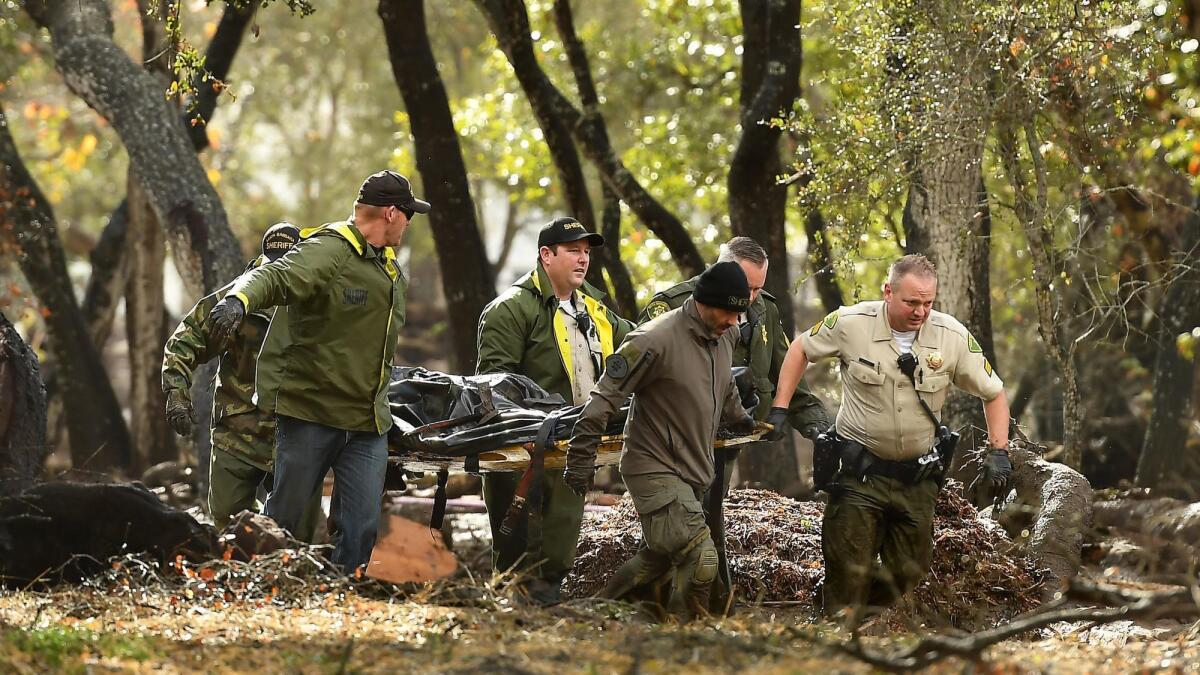After criticism over Montecito mudslide alerts, officials remove ‘voluntary’ from emergency warnings

- Share via
Santa Barbara County sheriff’s officials will no longer use “voluntary” in their evacuation alerts after concerns that the warnings they pushed out before devastating mudslides ravaged Montecito last month were ineffective in getting people to leave.
Many residents in neighborhoods under voluntary evacuation warnings decided to stay. Some assumed the threat was overblown just weeks after the Thomas fire triggered similar calls to evacuate.
“For some, the focus was on the word ‘voluntary’ rather than on the word ‘evacuation,’ ” Sheriff Bill Brown told reporters Thursday. “The reality is that some people misinterpreted that and believed that there was a measure of safety there that there really wasn’t.”
The consequences were deadly.
A majority of the 21 people killed when a torrent of mud and boulders swept through neighborhoods and destroyed homes on Jan. 9 lived in areas designated as voluntary evacuation zones. The two people still missing were also in those zones.
“All of us in retrospect, and in 20-20 hindsight, have to answer the question honestly: Was what we did sufficient on January the 8th?” Brown said at a community meeting Thursday evening. “And obviously, in retrospect, it was not.”
Now, 72 hours before any major storm, authorities will issue a pre-evacuation advisory putting the entire community on notice that residents should prepare to leave, said Undersheriff Bernard Melekian.
As the storm gets closer, affected neighborhoods will be divided into two evacuation categories: a recommended evacuation warning area and a mandatory evacuation order area.
“The new definitions are more clear,” said Kelly Hoover, a spokeswoman for the Sheriff’s Office. “We wanted to get the public right away familiar with these new evacuation definitions.”
For those under a recommended evacuation warning, authorities strongly encourage they find a safer place to shelter.
“It means that the danger exists, and it has been determined that you live in an area where there’s a high risk for loss of life and property,” Brown said. “While personal discretion is allowed, it is not advised.”
Those under a mandatory evacuation order — which indicates an “extreme risk for loss of life and property” — will be instructed to immediately head to a safer place.
Residents who ignore the order “should not expect rescue or other life-saving assistance after the onset of an emergency event,” Brown said.
“For the next few years,” he added, “we will all be experiencing a new normal about how we must deal with the potential dangers of approaching storms and resulting flooding and debris flows.”
In the days leading up to January’s storm, the county had issued numerous warnings about the possibility of mudflows on its website and social media, through news outlets and via community information emails that residents can sign up to receive.
But The Times reported earlier that the county did not send out Amber Alert-style bulletins to cellphones until the mudslides had begun. By then, it was too late for residents to flee.
The storm ended up being worse than expected, and the debris caused destruction much farther south than the initial estimates.
It’s not clear whether a broader evacuation warning would have made a difference. Officials estimated that only 15% of the residents in the mandatory evacuation zone left.
There were also technical glitches and conflicting maps that prevented earlier warnings from getting to residents.
Leading up to the storm, authorities released conflicting evacuation instructions that left the hardest-hit neighborhoods out of the warning zone.
The Sheriff’s Office posted a list of voluntary and mandatory evacuation areas for the town on Facebook and linked to the list from its website.
But a separate map on the county’s main website included a larger voluntary evacuation zone that included dozens of homes not covered by the sheriff’s list.
Times staff writer Joseph Serna contributed to this report.
More to Read
Sign up for Essential California
The most important California stories and recommendations in your inbox every morning.
You may occasionally receive promotional content from the Los Angeles Times.













